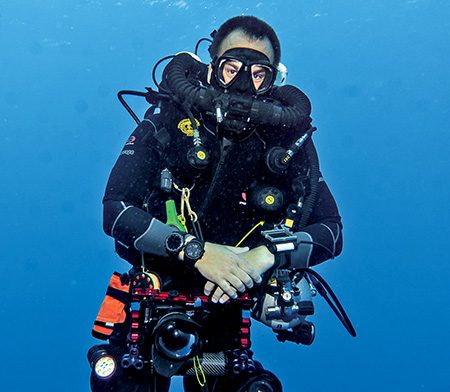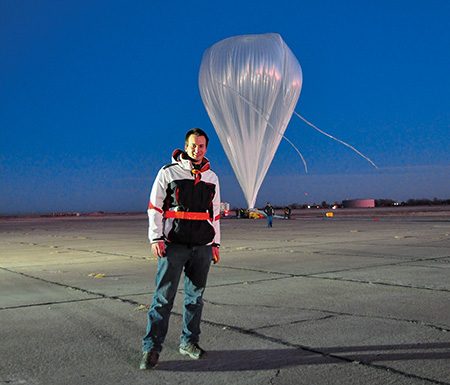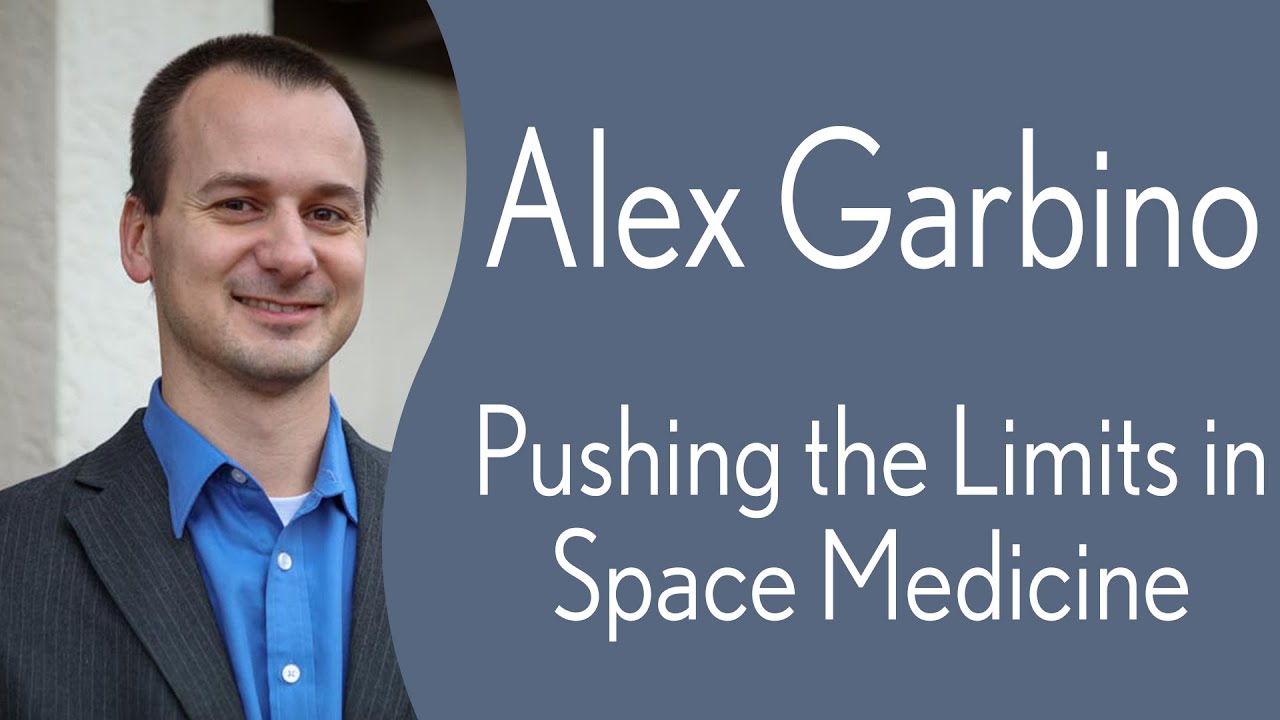Mitigating Decompression Sickness in Space
Born in Uruguay in 1982, Alejandro Garbino, MD, PhD, has been fascinated with air and sea since he was young. His passion for the air stemmed from an uncle who flew banner airplanes along the beach. Another uncle was a diver who liked to explore shipwrecks. Both of his parents are physicians, so medicine was the last thing he wanted to do.
Garbino grew up in Geneva, Switzerland, and after high school moved to Houston, Texas, with his high school sweetheart. They married soon afterward and now are raising four kids, and all are avid divers.
When did you start diving?
My now-wife and I started diving in the Mediterranean off the southern coast of France when I was 16 years old. We are very passionate about the ocean.
What sparked your interest in space research?
Since high school I’ve been drawn to all things space, physics, and astronomy. While pursuing my undergraduate degree in physics at the University of Houston Honors College, I found quantum mechanics and string theory too abstract. I wanted something more applicable to daily life, so I applied to an MD/PhD program at Baylor College of Medicine. The program included two years of medical school followed by a PhD program and another two years of medical school. During my PhD studies I worked with Jon Clark, MD, MPH, a retired NASA and Navy flight surgeon who mentored me on high-altitude and aerospace projects such as the Red Bull Stratos and StratEx extreme altitude jumps involving pressure suits.

That experience bridged my interests in diving and aerospace, as all spacesuit work and extravehicular activities (EVAs or spacewalks) combine elements of both disciplines. My curiosity expanded to rebreather physiology, particularly relating to spacesuits, which function similarly to rebreathers. I began rebreather diving in 2018.
After obtaining my MD/PhD, I completed a three-year emergency medicine program in Houston and got my private pilot’s license in 2010. I joined the aerospace medicine residency at the University of Texas Medical Branch in Galveston, Texas, to train as a flight surgeon for two years. That training involved exposure to remote environments, such as Antarctica, and analog field medicine scenarios through programs like the Antarctic medical program in collaboration with various institutions, including the Navy, Air Force, and private companies such as SpaceX.
You work on decompression protocols for space.
What does decompression sickness (DCS) have to do with space?
In 2018 I transitioned to NASA’s research division and joined the EVA physiology lab, focusing on spacesuit research. Since then my work has focused on the physiological impact of EVAs and working in spacesuits.
Managing pressure changes in different environments is one of the critical challenges of spacesuit design. While vehicles like the space shuttle and the International Space Station (ISS) maintain Earth-like conditions (one atmosphere of pressure, 21% oxygen), the spacesuit must operate in a vacuum, requiring much lower pressure — approximately one-third of Earth’s atmosphere. This scenario mirrors the challenges saturation divers face during ascent, where rapid pressure changes can pose significant risks due to decompression stress.

Workload is one of the big stressors for decompression sickness and bubble generation during human EVAs. My work at NASA primarily involves studying how to apply previous research and current exposures to design and test new decompression protocols — similar to dive tables adapted for space. For example, the rapid altitude change of transitioning from sea level (0 feet) to a spacesuit operating at one-third of atmospheric pressure (equivalent to approximately 30,000 feet or 9,144 meters) is like opening a window in a plane or ascending Mount Everest in minutes.
Spacesuits use pure oxygen to compensate for reduced oxygen at higher altitudes. Our research explores living environments at equivalent pressures of 12,000 to 16,000 feet (3,658 to 4,877 m), adjusting oxygen levels in the atmosphere from the typical 21% up to 30% or even 34%. This adjustment helps mitigate the physiological stress of transitioning from lower to higher altitudes. By reducing decompression stress, we can facilitate quicker transitions into the spacesuit, typically requiring hours of preparation and prebreathing oxygen to purge nitrogen.
Is prebreathing for astronauts the equivalent of a decompression stop in diving?
It’s a good analogy. Decompression stops allow nitrogen to leave the body during ascent. In contrast to diving, where oxygen toxicity limits oxygen intake, reduced pressures at altitude negate this concern, necessitating 100% oxygen use. Prebreathing oxygen purges nitrogen before transitioning to a lower-pressure environment.
For EVAs lasting six to eight hours, starting with a brief prebreathing session enables quicker suit entry. This approach is like saturation diving, where living in an intermediate atmosphere reduces the need for prolonged decompression stops, optimizing efficiency for daily spacewalks in programs such as Artemis. Like managing repetitive dives, this work encompasses decompression physiology and operational studies to explore intervals between spacewalks and recovery protocols to ensure crew safety and performance under lunar exploration demands.

Where can you test spacewalks or new EVAs to simulate the environment?
NASA’s Neutral Buoyancy Laboratory (NBL) and 20-foot (6-m) altitude chamber are the two main environments we use. In the NBL’s 6.2-million-gallon (23.5-million-liter) pool, we simulate moving in the suit by using the water’s buoyancy in place of reduced gravity. There are no antigravity or zero-gravity spacewalks with actual or prototype spacesuits. We adjust buoyancy using lead and foam packs and even add lunar regolith to the pool floor to simulate the environment.
The 20-foot (6-m) altitude chamber in Houston is a three-story facility where test subjects live and work in conditions simulating space missions. The top floor serves as a cognitive testing and crew quarters area, the middle floor houses the crew habitat, and the ground floor replicates lunar surface tasks and EVA simulations. Here we study the effects of different pressures on astronaut performance and test decompression models using ultrasound to monitor for venous gas emboli. This research aims to establish protocols for developing dive tables for safe and efficient spacewalks, ensuring crew safety and performance under lunar exploration conditions.
You’re doing this research to prevent DCS in space, but it seems improbable to have a portable hyperbaric chamber nearby. What would the protocol be for DCS in space?
That’s a big question, divided into two parts: the ISS and the Artemis lunar exploration program. A hyperbaric chamber in the airlock was originally planned for the ISS but ultimately deemed impractical due to structural concerns. Returning to the ISS from a spacewalk involves gradually increasing pressure in the suit back to sea level, often supplemented by using the airlock to pressurize further. This method, which uses the spacesuit as a makeshift hyperbaric chamber, can be extended by restricting the suit’s exhaust port to increase pressure. This can render the suit unusable for future flights, however, and requires a return to Earth for recertification. If necessary, astronauts can quickly return to Earth via the capsule for definitive medical care.
In contrast, astronauts on lunar missions may be days away from medical facilities on Earth, making immediate return impractical. Future spacesuit designs aim to operate at higher pressures to provide better treatment capability. Complete hyperbaric treatment equivalent to Earth’s facilities remains challenging, however, and ethical considerations preclude deliberate induction of DCS in humans for study. Animal studies and modeling will likely precede any human trials to assess the effectiveness of partial treatments in these unique low-pressure environments, such as those experienced on the moon.
Explore More
Watch Alex Garbino discuss “Pushing the Limits in Space Medicine.”
© Alert Diver – Q3 2024

